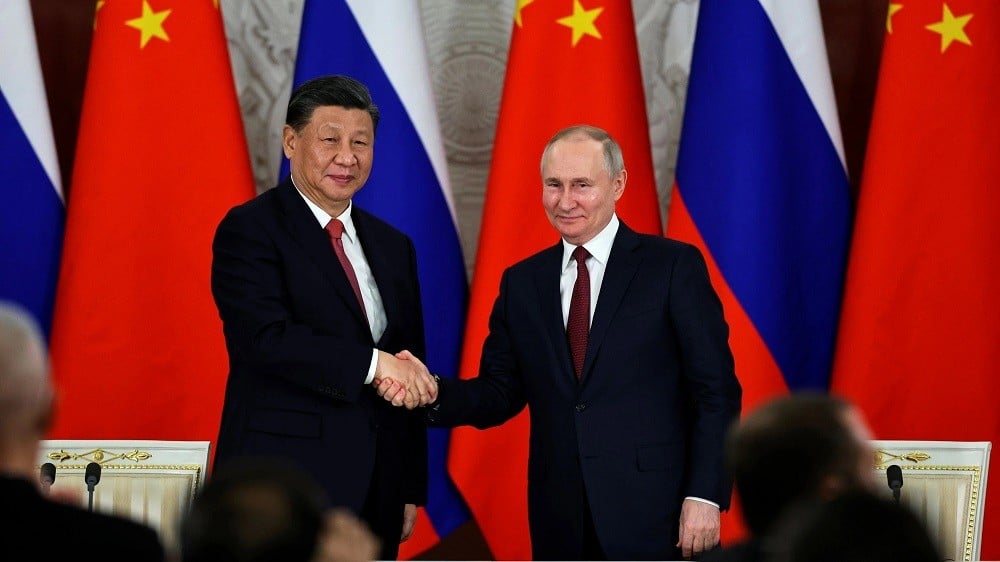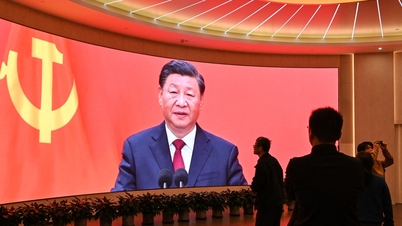 |
| Chinese President Xi Jinping (left) and Russian President Vladimir Putin at a joint press conference on March 21 in Moscow. (Source: AFP/Sputnik) |
Trade turnover at record high
According to official figures released by China on June 7, the country's total trade turnover with Russia in May skyrocketed to an unprecedented high since Moscow began its military campaign in Ukraine.
Accordingly, the trade value between the two countries in May 2023 reached 20.5 billion USD, with China's imports from Russia worth 11.3 billion USD.
Meanwhile, China's exports fell for the first time since February - breaking a two-month growth streak after the easing of Covid-19 measures.
Rising global inflation, the risk of recession in many countries and geopolitical tensions with the US have weakened demand for Chinese products.
According to Chinese customs data, in 2022, China was Russia's largest trading partner, with trade value reaching a record $190 billion.
At a summit in March, Chinese President Xi Jinping and Russian President Vladimir Putin pledged to boost trade to $200 billion by 2023. Both leaders hailed the partnership as “unlimited.”
Last month, Russian Deputy Prime Minister Alexander Novak said that Russian energy supplies to China would increase by 40% this year.
Figures released on June 7 also showed that Chinese exports to Russia increased by 75.6% in May, the highest level since the conflict in Ukraine broke out. Meanwhile, trade between the Northeast Asian country and most major markets in Europe and the United States decreased.
“Trade data for May showed a decline in global demand for Chinese goods,” said analysts at Capital Economics.
Waiting for a boost from Vladivostok port
Trade between China, especially its northeastern region, and Russia will be further boosted by Beijing’s decision to add Russia’s Vladivostok port to its list of transit ports for cross-border domestic trade. The decision took effect on June 1 amid growing demand for regional economic development.
Vladivostok is now Russia's largest port on the Pacific, also known by its historical name Haishenwai in Chinese, allowing traders to diversify routes and cut shipping costs, especially between industrial centers in the northeast and manufacturing and trading centers in southern China.
The new transshipment port, as a win-win cooperation mechanism, is expected to benefit regional economic development in Northeast China as well as Russia's Far East, experts said. This will create new momentum for bilateral trade and investment.
 |
| Since June 1, China has added Russia's Vladivostok port to its list of transit ports for transporting domestic goods across the border in northeastern Jilin Province. (Source: Shutterstock) |
According to a recent announcement by the General Administration of Customs of China (GAC), the decision to add Russia's Vladivostok port to the list of transit ports for cargo transportation in Jilin Province comes as Beijing implements a strategy to revive old industrial bases in the Northeast and promote cooperation with foreign ports in transporting cross-border domestic trade.
Zhoushan Yongzhou Container Port and Jiaxing Zhapu Port in East China's Zhejiang Province will be added as entry ports for trade with Vladivostok.
Previously, the provinces of Jilin and Heilongjiang in northeastern China were said to be hampered in economic and trade development because they had no access to the sea.
“The closest and most used domestic trade transit route in the region is currently via Dalian in Liaoning Province, with a distance of more than 1,000 kilometers,” said Kang Shuchun, director of the China Federation of Logistics and Purchasing. “Meanwhile, the distance between Vladivostok and major trading centers in Northeast China such as Suifenhe and Hunchun is only about 200 kilometers. Therefore, this is considered a shortcut that can significantly cut logistics costs.”
With the shorter distance, the delivery fee for each container shipped from Hunchun to Zhoushan Yongzhou Container Port via Vladivostok could be reduced by at least 2,000 yuan (about 281 USD), according to Mr. Kang.
China currently has 13 trade routes with Russia, most of which are scheduled weekly and are quite busy. The goods traded are quite diverse, from consumer goods to cars.
It is understood that after Vladivostok opens as an inland trade port, route adjustments will be made according to existing agreements. Many forwarding companies have expressed interest in this route.
Industry experts say that in addition to boosting the regional economy as well as trade cooperation between Beijing and Moscow, the Vladivostok transit port will allow more goods produced in Northeast China to be exported at competitive prices to South Korea, Japan and even Southeast Asia.
In addition to providing new advantages for bulk cargo trade in Northeast China, the Vladivostok transshipment port will strengthen logistics cooperation between China and Russia's Far East, said Zhang Hong, a researcher at the Institute of Russian, Eastern European and Central Asian Studies of the Chinese Academy of Social Sciences.
“Investment and trade in areas such as energy will be exploited,” the researcher said.
While agricultural products and vehicles produced in Northeast China can be quickly transported to markets in the south via the new route, border crossings involve customs supervision, according to media reports.
Making Russia's Vladivostok part of its transit port system for inland trade is one of Beijing's further efforts to boost regional trade and economy.
In 2020, Russia's Slavyanka seaport and Kraskino highway port were put into operation as transit ports for cross-border domestic trade cargo transportation in China's Jilin Province.
However, experts say it will take time to show the actual economic efficiency of the Vladivostok transit port for bilateral trade.
The new port would be one of several options, not the only one. There are currently three cross-border ports in Jilin, including one connected to North Korea and two to Russia, Mr. Zhang said.
In addition, this expert also commented that due to the vast land and sparse population in the Russian Far East, investing in infrastructure may not bring benefits in the near future.
Source







































































![[Infographic] Circular guiding the functions, tasks and powers of the provincial Department of Culture, Sports and Tourism and the commune-level Department of Culture and Social Affairs](https://vphoto.vietnam.vn/thumb/402x226/vietnam/resource/IMAGE/2025/6/29/877f24989bb946358f33a80e4a4f4ef5)































Comment (0)